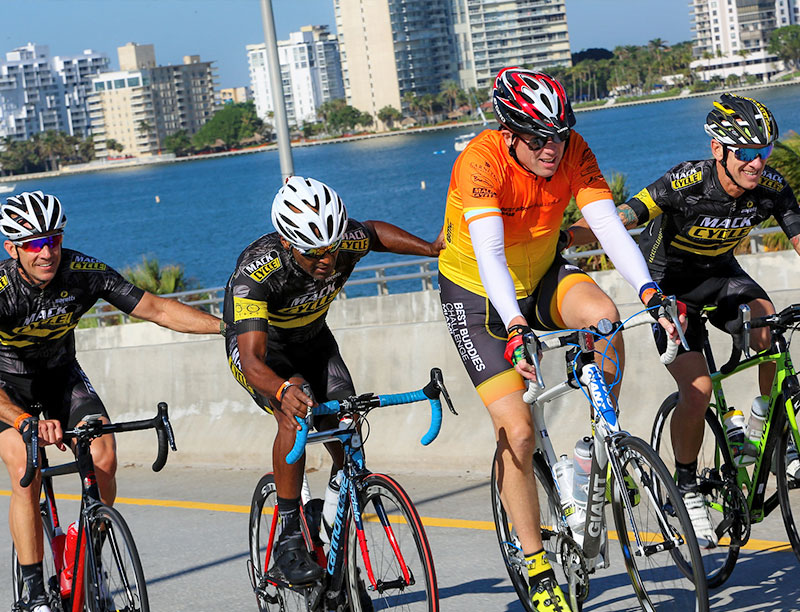Shiny Side Up; Rubber Side Down
Ten Basic Tips to Stay Upright on a Charity Ride

Although I’ve been racing both road and cyclo-cross, the last time I hit the deck hard was on a charity bike ride. Mind you, this was NOT a Best Buddies event, but spills can happen at the best run events.
With all my experience I could see this one happening well before things went terribly wrong. I had moved 20 feet to the right of this inexperienced rider attempting to show off. But somehow, as he crashed his flailing legs whipped his bike around with a hammertoss effect. His riderless bike shot across the road and right through my wheels.
I do remember the guy saying ”SORRY,” both as he went down and with the aftermath, a 20-rider pileup in which I landed in second place.
I got up hardly nicked and finished the ride. Smoldering with anger, every rider got up and finished, but some were seriously scraped up, notably the perpetrator. His ego had been crushed. Nobody wants to be THAT guy. In replaying that incident over and over in my head I could catalogue so many mistakes that rider, and I, made that day.
Hitting the floor sucks. But if you focus on a few basic skills, you are 99.9 percent likely to keep the rubber side down. Here are some time honored and race proven tips for not just keeping yourself upright, but also not causing harm to others and shame to yourself.
10 Tips to Staying Upright:
- Ride The Right Bike. A rider on an ill-fitting bike is a crash waiting to happen. Either riding a bike too small – a la Magilla Gorilla – or a bike too big – which is like straddling a barn door – is going to be a problem.
- Eyes Forward; Hands Free. This is a chronic problem for races, tours and charity events alike. And with computers, mirrors, tablets, headphones, bells, phones, lights, cameras and other crap taking up the valuable space not just on their handlebars but in their brains, riders are increasingly distracted. Get rid of all but your bicycle computer and put the phone in your back pocket. Being 100 percent focused on what’s in front of you will prevent 90 percent of the mishaps out there. The responsibility for mishaps on the road – with cars or bicycles – is the person in the back.
- Be Deliberate. Experienced riders will often tell newbies “hold your line.” And they’ll refer to a rookie as a “squirrel”, referring to a twitchy, indecisive rider. It matters less that you select the right “line” to ride; more that stick to it. When you do need to change lines move in a smooth, deliberate fashion in a manner that is safe and courteous.
- Pick One Foot. When I need to stop I typically unclip with my left foot, given the presence of a greasy chain on the right side of the bike. Most experienced riders do the same and they stay with that foot for 95 percent of the times they stop. The foot is not placed straight down to the ground but far to the left, like an outrigger on a boat, to prevent a fall to the right. And don’t take both feet out unless you are getting entirely off the bike. Keeping a foot in means you can skedaddle faster when you need to.
- Always Have a B-line. “There was nowhere for me to go,” complained a rookie after a spill in a large group ride. “Well, why were YOU there?” was my reply. Factoring in both the road and the riders around them, good riders always have an alternative line to the one they are on, which may include going into grass, gravel, or dirt. But it’s there. Don’t put the front wheel into a space if you cannot get it out.
- Use Your Hands. A simple skill to master in a large group, especially as it compresses together at lower speeds during the initial rollout, is the ability to safely put your hand on the back of the rider next to you. This is not aggressive. This is a defensive skill to keep both of you upright. Practicing on smaller group rides is advised.
- Brake Early and Evenly. Many problems are caused by riders who suddenly grab whole handfuls of brake. This will ripple throughout the entire field, possibly causing crashes several riders removed from the initial incident. Provided you are following tips 1-5 you will likely be in a position to respond to most contingencies that arise on the road. Brake smoothly at the earliest indication of a problem, preferably with the rear brake. You’ll easily be able to resume the pace thereafter.
- Learn the ‘Attack Position.’ Relax, it’s not some aggressive, radical racing move. Watch any mountain biker drop into a steep ravine. They do three things: 1) bend the elbows, 2) come off the saddle; and 3) move the body and weight down and back, coming off the rear of the saddle. This makes the bike very stable and converts the entire body into a suspension system. This position enables a rider to brake hard without going over the handlebars or to strike a rough patch of pavement with little risk of crashing. Mastering this position is crucial to group riding.
- Find the Late Apex. Bicycle crashes commonly occur when riders “over-cook” a turn. They go into the turn fast only to realize they are running out of road, forcing them into bad choices. This is typically the result of steering into the turn too soon, what racers refer to as the early “apex”. The apex is the most acute portion of the turning radius. By staying wide of the turn later, a rider will then be able to carve a wider, smoother line with a “late apex” that is safer.
- DO NOT SHOW OFF! Ok, most women don’t need to read this. Most men do. This is how the stupidest and worst crashes happen at some of the highest speeds. Including the one described above. Don’t be that guy. Please save the jokes for the beer tent and the stunts for the parking lot afterwards.
 Richard Fries is the Director of Cycling Experience for the Best Buddies Challenges. With more than 40 years experience, he has been a racer, commuter, tourist, promoter, advocate, journalist and commentator on the sport and lifestyle of cycling. Having raced at the professional level both in America and Europe, Fries is well known as a race announcer having called countless USA Cycling National Championships, World Cups, and UCI World Championships. But he is also a tireless advocate having recently served as the executive director of MassBike. You can follow him on Strava to learn more.
Richard Fries is the Director of Cycling Experience for the Best Buddies Challenges. With more than 40 years experience, he has been a racer, commuter, tourist, promoter, advocate, journalist and commentator on the sport and lifestyle of cycling. Having raced at the professional level both in America and Europe, Fries is well known as a race announcer having called countless USA Cycling National Championships, World Cups, and UCI World Championships. But he is also a tireless advocate having recently served as the executive director of MassBike. You can follow him on Strava to learn more.




